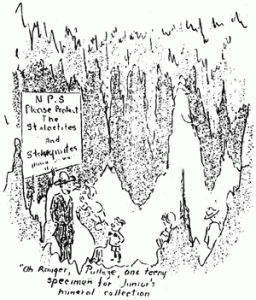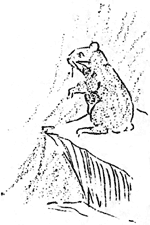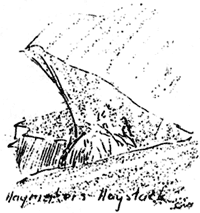Cave
By Park Naturalist D. S. Libbey
The rediscovery of a cavern in the area of Crater Lake National Park is of considerable interest. It is located along the north exposure of the cliff midway between Mt. Scott and the lake, about three-fourths of a mile away from the Rim. The grotto is not one formed by the flowing of lava through a passage way, a lava tunnel, but is a cavity caused by the solution activity of ground water.
The cavern is about 200 feet long and extends backward into the cliff of andesite rock. The mouth is about 50 feet wide and from 7 to 8 feet high. The walls are covered in many places by stalactitic deposits. Curiously these cave deposits are not calcareous but are siliceous. It appears that the weathering action has caused the plagioclase feldspar to be decomposed and the resulting solution activity has caused the silica to be taken into solution and then to be deposited when exposed to the air. Many surfaces are covered with siliceous dripstone formations.
This cave was discovered during the current season by a group of workmen engaged in the Pine Beetle Control work. There is a story attached to this cave.
The story says that an Indian named Pedro years ago visited Linkville, now called Klamath Falls, and told of a very rich gold deposit he had discovered. Two Indians in the vicinity of Linkville followed Pedro back to the region and there found that in place of having discovered a gold deposit that Pedro had found two prospectors carrying very valuable sacks of gold. He murdered the prospectors and cached the stolen plunder in the cave. So goes the story, the authenticity of this seems to be varified by the fact that our park workmen found the cave in exactly the location described by an old Indian this current summer.
Facts, Fancies and Nebulous Thoughts
By Ranger Frank Solinsky
You have finished the geologist’s explanation of the cave — terse scientific facts as to its origin. But were you satisfied? Even the knowledge that the cave was comparable to a robber’s den does not offset the disappointment of disillusionment. The majestic awe and mystery of Crater Lake is conducive to fantastic thoughts and leads to the contemplation of ancient Deities, terrifying and sinister in their Aladdin-like ability to manipulate the mighty forces of Nature. To start, rumblings and movements in the bowels of the earth which end only with the destruction of great mountains and the complete obliteration of towns, cities and even races.
Let your fancy run wild — draw a picture in your mind of Dante’s “Inferno” — harken back to Vulcan. Possibly even now the bellows of his forge are breathing new life into this mountain and if we but murmur the magic words of Ala Baba, the rocks in the recesses of the cave will move and enable us to enter his workshop, far below the waters of the lake. Is this impossible? Does not this mountain exemplify vulcanism — lava flows, great dikes, cinder cones, and an immense caldera? Do not our Greek Mythologists go into elaborate detail in describing the entrance to Hades and furnish a map that will guide us through the intricate passages of the nether regions until finally we arrive at the Elysian Fields?
Give your imagination complete control and after a fascinating flight, arrive exhausted on the rim of the lake where suddenly the beauty and charm of the cliffs and the blue water will soften the tremendous forces and you will truly enter these Elysian Fields.
Haymaker
By Ranger Naturalist E. W. Count
An absurd little beast is the Pika or Cony (Ochotona f. fumosa).In front, he looks like a small rat; behind, his bobtail proclaims him a rabbit. As a matter of fact, he is the small cousin of the rabbit, and is not a rodent at all. If you gave him long ears, instead of those odd, little, mouse-like funnels, a rabbit he would immediately appear to be.
There are many of him in the rocks that jumble together at the foot of the slide that frowns at the boat-landing. The funny, whistling little bleat often maddens you because it does not always proclaim the whereabouts of its author. For the Cony minds his own business, and, unlike the Ground Squirrels, refuses to come to terms with the two-legged giants that run, tramp, or stagger and puff on the trail from shore to rim.
And why should he? – The two-legged animals have nothing to offer. Peanuts are for squirrels, but not for the bona fide cousin of rabbits. A Cony feeds on plant bodies, not on seeds.
Ray Telford, the “Admiral of the Crater Lake Navy”, reports that nothing can be more absurd than a Cony crouched comfortably, a long green stalk projecting far out from his mouth like the straw of the ruminating hill-billy, and the near end rapidly disappearing as those rabbit-cheeks munch solemnly. The stalk shrinks and disappears, leaving the Cony sitting there alone.
One article of diet surprised me. A little fellow was engaged in eating the full blossoms of the Lewis’ monkey flower. Earlier in the season a Cony was reported snipping off and rejecting the heads of sulfur flowers but cutting down and stacking the leaves and stems.
Under the rocks are the piles of hay. For this tiny buccolic engages in stacking the stems of many plants, that they may dry into hay in the crevices. On examining several such piles, I concluded that no kind of plant growing on the trail was rejected. There were, among others, fireweed, Lewis’ monkey flower, (these two with the blossoms still on them), some species of Rubus, false solomon’s seal, false hellebore, half an orange-skin, and even the black paper cup from a large chocolate cream!
Mystery at North Entrance
By Ranger R. P. Andrews
Creeping slowly up the shoulder of Mount Scott, the rising sun cast its first wan rays upon the slope of the northwest rim. The crest of the Rim was alive with a shimmering, opalescent light, for during the night the breeze from the north had stooped and brushed the earth with the summer’s first white frost. The breeze had died, however, and now the air was hushed and still. Even the lake, far below, lay motionless in the gunmetal shadow of Cloud Cap. Gradually the sun cleared the shoulder of Scott, and its warmth became perceptible. And then occurred a curious thing. I became aware of a murmuring as of leaves stirred by a gentle breeze, but the air was motionless. I walked to where a group of hemlocks stood, seemingly immobile. Standing beneath them I looked up, but not a branch moved, not a twig quivered. Still that rustling murmur continued, and the air remained motionless. I walked back to my original place and listened. It was fainter now. The rustling had sunk to the merest whisper. I strained my ears. The sound was gone. The sun was well up now, and I could hear the throbbing of a motor approaching from the Diamond Lake Junction. Puzzled, I walked back to the cabin for my permit book.
For two days I pondered that peculiar susurration, that rustling of leaves from invisible trees. And three chilly mornings I rose before sunrise to be at the Rim to hear it. On the third morning I solved the mystery – mere by accident than by logic. Again everything was silent; the air motionless and the lake without a ripple. Again the earth was white with frost. Then, as the sun rose, the same gradually increasing rustle commenced, seeming to rise from the ground itself. I sat staring vacantly down the slope of the Rim, wondering. A slight movement a few feet down the slope attracted my eye, but I was too slow to catch it. Again I stared at the ground, this time with purpose. Four feet before my eyes a pebble shifted and rolled over twice. Another. And another. The whole slope was in motion toward the Lake! The mystery was solved!
During the night tiny frost crystals had formed beneath these light pumice pebbles, raising them ever so slightly. The sudden heat of the rising sun melted these fragile supporting crystals instantaneously, and the pebbles dropped suddenly. Sometimes they would settle back into place, but more generally the abrupt shift of the pebble’s equilibrium, situated as it was on a steep slope, would cause it to roll downward for a distance varying from a fraction of an inch to as much as four inches. The infinitesimal sound produced by this process, when multiplied several thousand fold, had produced in its totality a sound resembling that produced by a breeze in the forest. And thus slowly, with infinite patience, Nature was making use of one of her varied tools to accomplish here work of wearing down the Rim.




